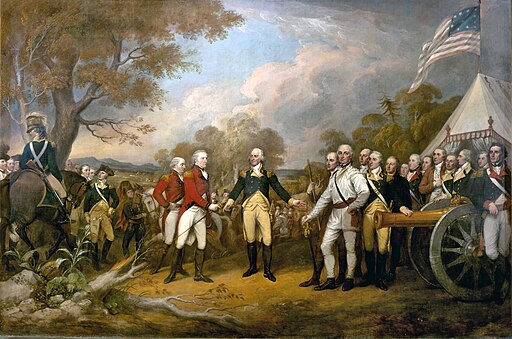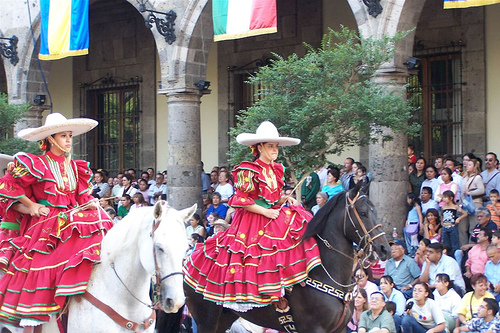
“Surrender of General Burgoyne” by John Trumbull depicts the British surrender at Saratoga, New York, in 1777, after the Second Battle of Saratoga.
The American victory was a turning-point and an enormous morale boost. It also convinced France to enter the war in alliance with the United States, openly providing money, soldiers, and munitions and fighting a naval war worldwide against Britain.
The depiction includes many leaders of the American Continental Army and militia forces that took part in the battle. The central figure represents the American General Horatio Gates.
Burgoyne is shown giving his sword to Gates, who immediately returned it as a sign of respect and invited him into his tent.
All of the figures in the scene are portraits of specific officers. Trumbull planned this outdoor scene to complement his painting Declaration of Independence.
The American officers are shown gathered at the sides to witness the event. The officers wear their dress uniforms, their weapons are sheathed or slung, and cannons stand silent.
The American’s varied dress reflects their different units. Also shown is the Hessian commander Friedrich Adolf Riedesel and the two British Army officers in red-coats are Burgoyne and General William Phillips.
The painting was completed in 1821 and hung in the United States Capitol’s rotunda in Washington, D. C. Trumbull also created a smaller version exhibited at the Yale University Art Gallery.
The rotunda version was used as the basis for a commemorative stamp issued in 1994.

1927 sesquicentennial commemorative stamp
John Burgoyne
General John Burgoyne (1722 – 1792) was a British officer and politician who sat in the House of Commons from 1761 to 1792. Burgoyne is best known for his role in the American Revolutionary War.
During the war, he designed an invasion scheme and commanded a force moving south from Canada to split away New England and end the rebellion.
Burgoyne advanced from Canada, but his slow movement allowed the Americans to prepare their forces. According to his plan, the British Army in New York City was tasked with moving north to assist. Instead, they moved south to capture Philadelphia.
Burgoyne fought two small battles near Saratoga but was surrounded and outnumbered by American forces, and, with no relief in sight, he surrendered his entire army of 6,200 men on 17 October 1777.
Burgoyne’s army surrendered with full honors of war and marched past to stack arms as the American and British bands played “Yankee Doodle” and “The British Grenadiers.”
The British government of Lord North came under sharp criticism when the news of Burgoyne’s surrender reached London. Lord North issued a proposal for peace terms in Parliament that did not include independence, but when these were delivered to Congress, they were rejected.
Burgoyne and his officers returned to England, but the enlisted British became prisoners of war. Burgoyne was criticized when he returned to London and never held another active command.

Engraving used on the reverse of the $500 National Bank Note.
Surrender of General Burgoyne
- Title: Surrender of General Burgoyne
- Artist: John Trumbull
- Year: 1821
- Medium: Oil on canvas
- Dimensions: Height: 365.7 cm (12 ft); Width: 548.6 cm (18 ft)
- Category: History Painting, American Art
- Museum: United States Capitol, Yale University Art Gallery
John Trumbull
John Trumbull (1756–1843) was born in Connecticut, the son of the governor. After graduating from Harvard University, he served in the Continental Army under General Washington.
He then studied painting with Benjamin West in London and focused on history painting. Trumbull painted many scenes from the American Revolutionary War and was notable for his historical paintings.
His painting “Declaration of Independence” was used on the commemorative bicentennial two-dollar bill. Trumbull also incorporated the actual likeness of his subjects into his depiction of historical paintings.
John Trumbull
- Name: John Trumbull
- Born: 1756 – Lebanon, Colony of Connecticut, British America
- Died: 1843 (aged 87) – New York, New York, U.S.
- Nationality: American
- Notable works:
- John Adams
- The Capture of the Hessians at Trenton, December 26, 1776
- Alexander Hamilton
- Self-Portrait
- The Death of General Warren at the Battle of Bunker’s Hill, June 17, 1775
- Declaration of Independence
- Surrender of Lord Cornwallis
- The Death of General Montgomery in the Attack on Quebec, December 31, 1775
- Surrender of General Burgoyne
Burgoyne’s Surrender at Saratoga
A Tour of History Paintings
- “Washington Crossing the Delaware” by Emanuel Leutze
- “The Family of Darius before Alexander” by Paolo Veronese
- “Las Meninas” or “The Ladies-in-Waiting” by Diego Velázquez
- “The Third of May 1808″ by Francisco Goya
- The Second of May 1808 – The Charge of the Mamelukes by Francisco de Goya
- “The Fighting Temeraire” by Joseph Mallord William Turner
- “Westward the Course of Empire Takes Its Way” by Emanuel Leutze
- “The Capture of the Hessians at Trenton, December 26, 1776″ by John Trumbull
- “The March to Valley Forge” by William B. T. Trego
- “The Massacre at Chios” by Eugène Delacroix
- “The Execution of Lady Jane Grey” by Paul Delaroche
The Battle of Saratoga
- Cromwell in Battle of Naseby” by Charles Landseer
- “The Surrender of Breda” by Diego Velázquez
- “Hannibal and his Army Crossing the Alps” by J. M. W. Turner
- “The Death of Marat” by Gioacchino Giuseppe Serangeli after Jacques-Louis David
- “Oath of the Horatii” by Jacques-Louis David
- “The Coronation of Napoleon” by Jacques-Louis David
- “The Burning of the Houses of Lords and Commons by J. M. W. Turner
- “The Burning of the Houses of Parliament” by J. M. W. Turner
- “The Triumph of Cleopatra” by William Etty
- “Dempsey and Firpo” by George Bellows
- Floreat Etona! by Elizabeth Thompson
- Scotland Forever! by Elizabeth Thompson
- “Surrender of Lord Cornwallis” by John Trumbull
Saratoga: Turning Point of the American Revolution
~~~
“I hope I shall possess firmness and virtue enough to maintain what I consider the most enviable of all titles, the character of an honest man.”
– George Washington
~~~
Photo Credit: 1)John Trumbull, Public domain, via Wikimedia Commons; Bureau of Engraving and Printing; Imaging by Gwillhickers, Public domain, via Wikimedia Commons; Frederick Girsch with the National Bank Note Company, for the Bureau of Engraving and Printing, Public domain, via Wikimedia Commons.
Popular this Week








 Sponsor your Favorite Page
Sponsor your Favorite Page SEARCH Search for: Search Follow UsJoin – The JOM Membership Program
Sponsor a Masterpiece with YOUR NAME CHOICE for $5
Share this:
- Tweet
